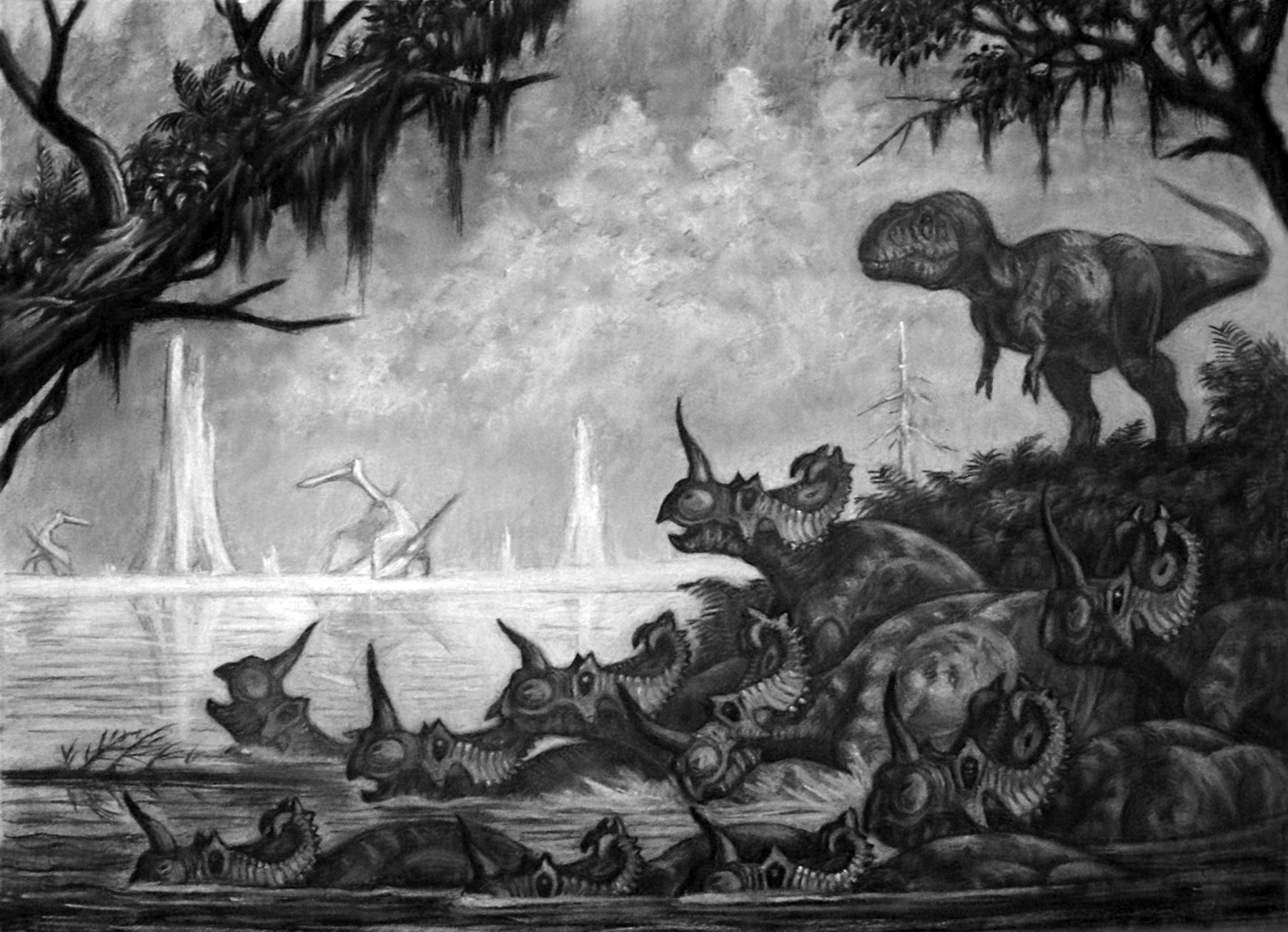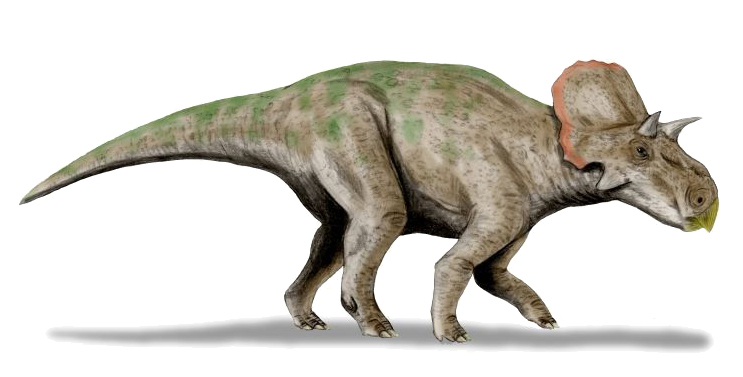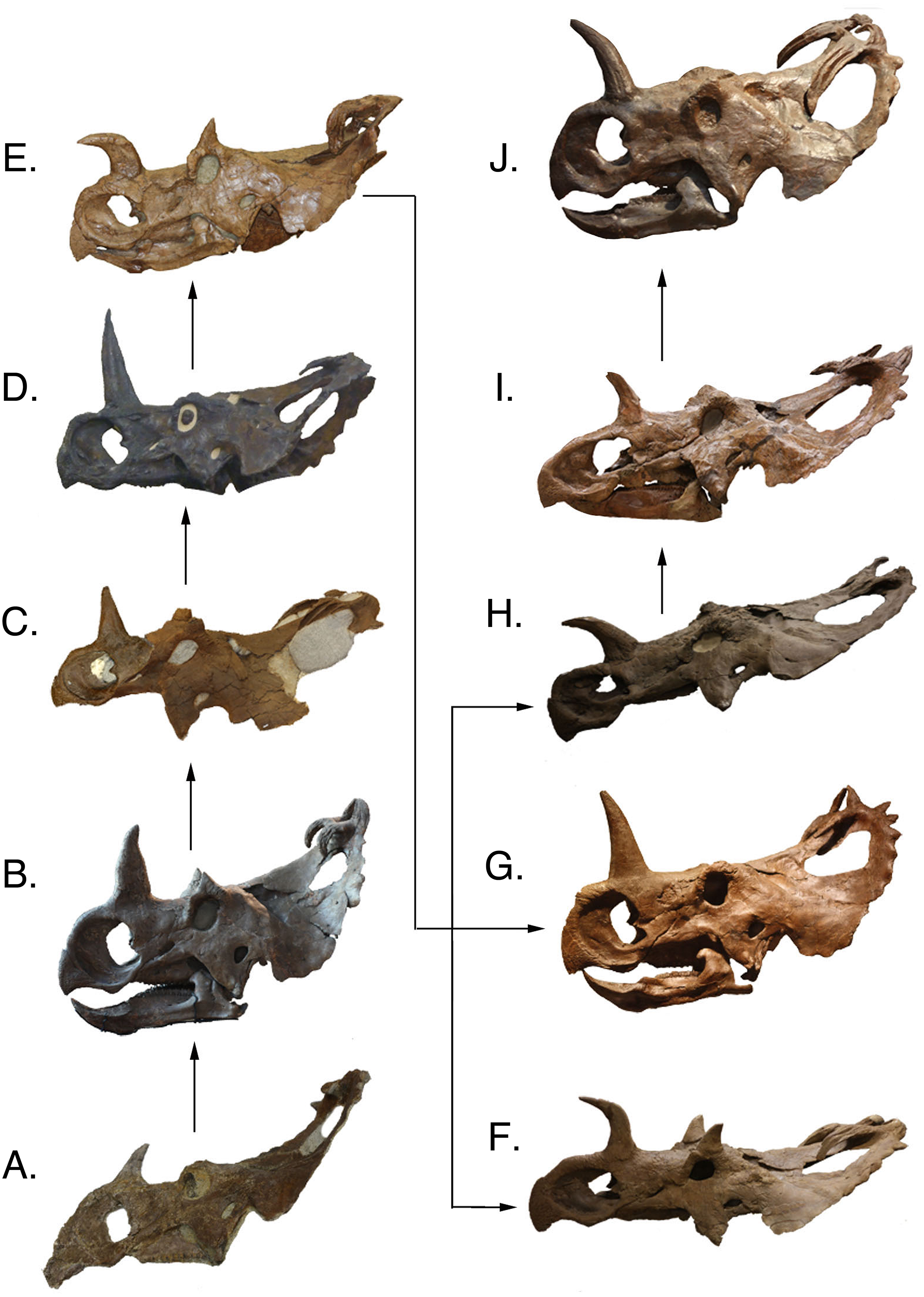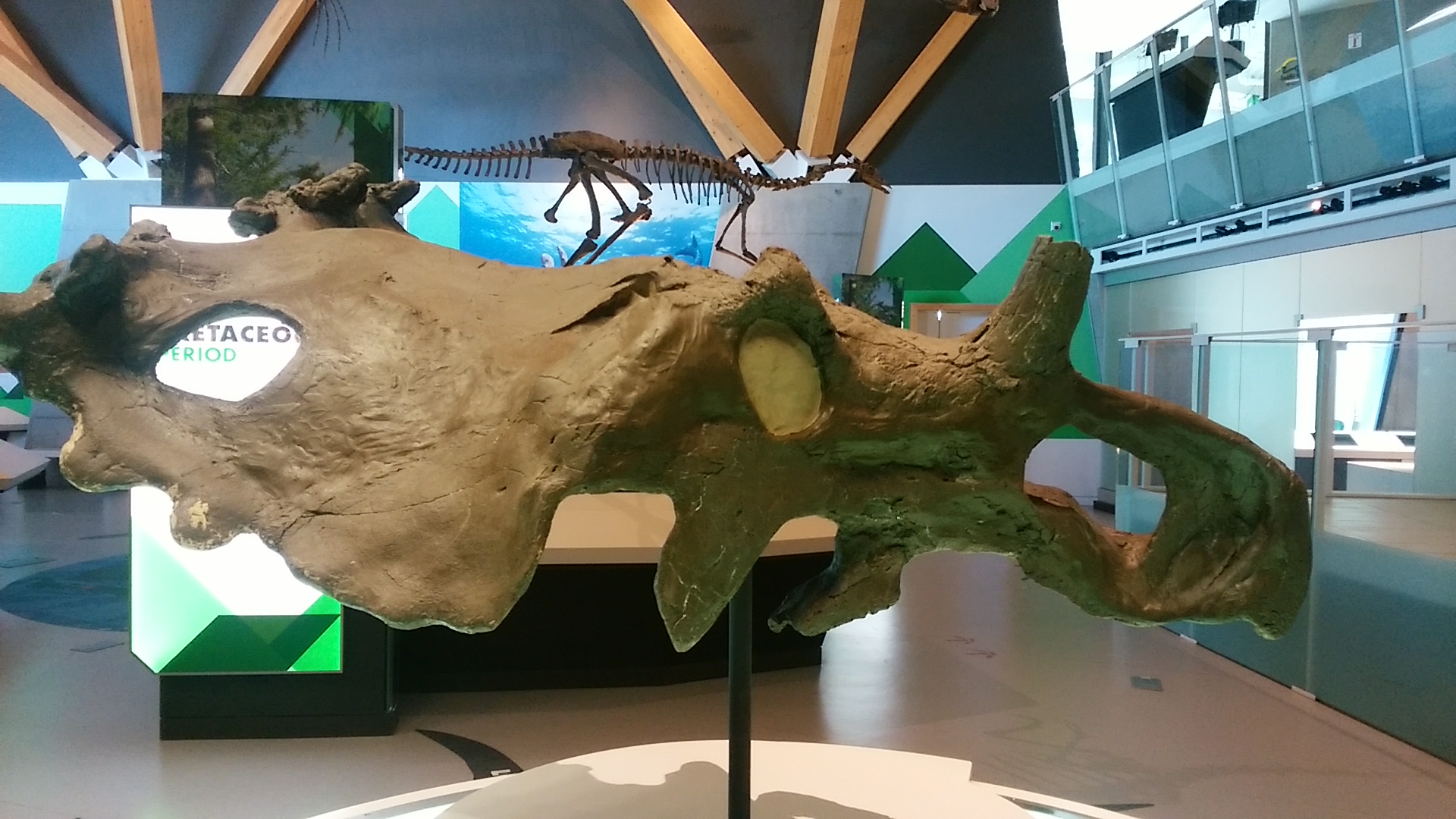|
Centrosaurus Apertus
''Centrosaurus'' ( ; ) is a genus of herbivorous ceratopsian dinosaur from the Late Cretaceous of Canada. Their remains have been found in the Dinosaur Park Formation, dating from 76.5 to 75.5 million years ago. Discovery and naming The first ''Centrosaurus'' remains were discovered and named by paleontologist Lawrence Lambe in strata along the Red Deer River in Alberta, Canada. The name ''Centrosaurus'' means "pointed lizard" (from Greek ', , "point or prickle" and ', , "lizard"), and refers to the series of small hornlets placed along the margin of their frills, not to the nasal horns (which were unknown when the dinosaur was named). The genus is not to be confused with the stegosaur ''Kentrosaurus'', the name of which is derived from the same Greek word. Later, vast bonebeds of ''Centrosaurus'' were found in Dinosaur Provincial Park, also in Alberta. Some of these beds extend for hundreds of meters and contain thousands of individuals of all ages and all levels of completi ... [...More Info...] [...Related Items...] OR: [Wikipedia] [Google] [Baidu] |
Late Cretaceous
The Late Cretaceous (100.5–66 Ma) is the younger of two epochs into which the Cretaceous Period is divided in the geologic time scale. Rock strata from this epoch form the Upper Cretaceous Series. The Cretaceous is named after ''creta'', the Latin word for the white limestone known as chalk. The chalk of northern France and the white cliffs of south-eastern England date from the Cretaceous Period. Climate During the Late Cretaceous, the climate was warmer than present, although throughout the period a cooling trend is evident. The tropics became restricted to equatorial regions and northern latitudes experienced markedly more seasonal climatic conditions. Geography Due to plate tectonics, the Americas were gradually moving westward, causing the Atlantic Ocean to expand. The Western Interior Seaway divided North America into eastern and western halves; Appalachia and Laramidia. India maintained a northward course towards Asia. In the Southern Hemisphere, Australia and Ant ... [...More Info...] [...Related Items...] OR: [Wikipedia] [Google] [Baidu] |
Hilda Mega-bonebed
The Hilda mega-bonebed is a complex of fourteen probable ''Centrosaurus apertus'' bonebeds discovered near the town of Hilda in Alberta, Canada. It was first described in the scientific literature by David Eberth, Donald Brinkman, and Vaia Barkas in 2010 after more than ten years of research. The Hilda mega-bonebed is significant because the behavior of the preserved dinosaurs themselves was the dominant cause of its existence, rather than the stratum's geological history like most bonebeds. It is also Canada's largest bonebed. History of research In 1959, Wann Langston, Jr. recorded evidence of a ''Centrosaurus'' bonebed near Hilda, Alberta. Later, between 1964 and 1966 Don Taylor of the Provincial Museum of Alberta (now called the Royal Alberta Museum) oversaw the collection of fossils from yet another bonebed in the same region. These prospective bonebeds attracted the attention of scientists working for the Royal Tyrell Museum in the 1990s because Hilda was an ideal location f ... [...More Info...] [...Related Items...] OR: [Wikipedia] [Google] [Baidu] |
Avaceratops
''Avaceratops'' is a genus of small herbivorous ceratopsian dinosaurs which lived during the late Campanian during the Late Cretaceous Period in what are now the Northwest United States. Most fossils come from the Judith River Formation. Discovery and naming The first remains of ''Avaceratops'' were found by fossil dealer Eddie Cole in the Judith River Formation of Montana, in 1981, on land of the Careless Creek Ranch, owned by rancher Arthur J. Lammers."Avaceratops." In: Dodson, Peter & Britt, Brooks & Carpenter, Kenneth & Forster, Catherine A. & Gillette, David D. & Norell, Mark A. & Olshevsky, George & Parrish, J. Michael & Weishampel, David B. ''The Age of Dinosaurs''. Publications International, LTD. p. 129. . They were preserved scattered throughout the remains of a prehistoric stream bed. This ''Avaceratops'' specimen was likely buried in the sandbar after its body was swept downstream by the current. The finds, displayed in Cole's fossil shop, were in October 1981 inspect ... [...More Info...] [...Related Items...] OR: [Wikipedia] [Google] [Baidu] |
Pachyrhinosaurus
''Pachyrhinosaurus'' (meaning in Greek "thick-nosed lizard", from ' (), thick; ' (), nose; and (), lizard) is an extinct genus of centrosaurine ceratopsid dinosaur from the Late Cretaceous period of North America. The first examples were discovered by Charles M. Sternberg in Alberta, Canada, in 1946, and named in 1950. Over a dozen partial skulls and a large assortment of other fossils from various species have been found in Alberta and Alaska. A great number were not available for study until the 1980s, resulting in a relatively recent increase of interest in ''Pachyrhinosaurus''. Three species have been identified. ''P. lakustai'', from the Wapiti Formation, the bonebed horizon of which is roughly equivalent age to the upper Bearpaw and lower Horseshoe Canyon Formations, is known to have existed from about 73.5–72.5 million years ago. ''P. canadensis'' is younger, known from the lower Horseshoe Canyon Formation, about 71.5–71 Ma ago and the St. Mary River Formation. ... [...More Info...] [...Related Items...] OR: [Wikipedia] [Google] [Baidu] |
Clade
A clade (), also known as a monophyletic group or natural group, is a group of organisms that are monophyletic – that is, composed of a common ancestor and all its lineal descendants – on a phylogenetic tree. Rather than the English term, the equivalent Latin term ''cladus'' (plural ''cladi'') is often used in taxonomical literature. The common ancestor may be an individual, a population, or a species (extinct or extant). Clades are nested, one in another, as each branch in turn splits into smaller branches. These splits reflect evolutionary history as populations diverged and evolved independently. Clades are termed monophyletic (Greek: "one clan") groups. Over the last few decades, the cladistic approach has revolutionized biological classification and revealed surprising evolutionary relationships among organisms. Increasingly, taxonomists try to avoid naming taxa that are not clades; that is, taxa that are not monophyletic. Some of the relationships between organisms ... [...More Info...] [...Related Items...] OR: [Wikipedia] [Google] [Baidu] |
Styracosaurus
''Styracosaurus'' ( ; meaning "spiked lizard" from the Ancient Greek / "spike at the butt-end of a spear-shaft" and / "lizard") is a genus of herbivorous ceratopsian dinosaur from the Cretaceous Period (Campanian stage), about 75.5 to 74.5 million years ago. It had four to six long parietal spikes extending from its neck frill, a smaller jugal horn on each of its cheeks, and a single horn protruding from its nose, which may have been up to long and wide. The function or functions of the horns and frills have been debated for many years. ''Styracosaurus'' was a relatively large dinosaur, reaching lengths of and weighing about . It stood about tall. ''Styracosaurus'' possessed four short legs and a bulky body. Its tail was rather short. The skull had a beak and shearing cheek teeth arranged in continuous dental batteries, suggesting that the animal sliced up plants. Like other ceratopsians, this dinosaur may have been a herd animal, travelling in large groups, as sugges ... [...More Info...] [...Related Items...] OR: [Wikipedia] [Google] [Baidu] |
Centrosaurus Skulls
''Centrosaurus'' ( ; ) is a genus of herbivorous ceratopsian dinosaur from the Late Cretaceous of Canada. Their remains have been found in the Dinosaur Park Formation, dating from 76.5 to 75.5 million years ago. Discovery and naming The first ''Centrosaurus'' remains were discovered and named by paleontologist Lawrence Lambe in strata along the Red Deer River in Alberta, Canada. The name ''Centrosaurus'' means "pointed lizard" (from Greek ', , "point or prickle" and ', , "lizard"), and refers to the series of small hornlets placed along the margin of their frills, not to the nasal horns (which were unknown when the dinosaur was named). The genus is not to be confused with the stegosaur ''Kentrosaurus'', the name of which is derived from the same Greek word. Later, vast bonebeds of ''Centrosaurus'' were found in Dinosaur Provincial Park, also in Alberta. Some of these beds extend for hundreds of meters and contain thousands of individuals of all ages and all levels of completi ... [...More Info...] [...Related Items...] OR: [Wikipedia] [Google] [Baidu] |
Centrosaurus Parietal Hook By Nick Longrich
''Centrosaurus'' ( ; ) is a genus of herbivorous ceratopsian dinosaur from the Late Cretaceous of Canada. Their remains have been found in the Dinosaur Park Formation, dating from 76.5 to 75.5 million years ago. Discovery and naming The first ''Centrosaurus'' remains were discovered and named by paleontologist Lawrence Lambe in strata along the Red Deer River in Alberta, Canada. The name ''Centrosaurus'' means "pointed lizard" (from Greek ', , "point or prickle" and ', , "lizard"), and refers to the series of small hornlets placed along the margin of their frills, not to the nasal horns (which were unknown when the dinosaur was named). The genus is not to be confused with the stegosaur ''Kentrosaurus'', the name of which is derived from the same Greek word. Later, vast bonebeds of ''Centrosaurus'' were found in Dinosaur Provincial Park, also in Alberta. Some of these beds extend for hundreds of meters and contain thousands of individuals of all ages and all levels of completi ... [...More Info...] [...Related Items...] OR: [Wikipedia] [Google] [Baidu] |
Fenestra (anatomy)
A fenestra (fenestration; plural fenestrae or fenestrations) is any small opening or pore, commonly used as a term in the biological sciences. It is the Latin word for "window", and is used in various fields to describe a pore in an anatomical structure. Biological morphology In morphology, fenestrae are found in cancellous bones, particularly in the skull. In anatomy, the round window and oval window are also known as the ''fenestra rotunda'' and the ''fenestra ovalis''. In microanatomy, fenestrae are found in endothelium of fenestrated capillaries, enabling the rapid exchange of molecules between the blood and surrounding tissue. The elastic layer of the tunica intima is a fenestrated membrane. In surgery, a fenestration is a new opening made in a part of the body to enable drainage or access. Plant biology and mycology In plant biology, the perforations in a perforate leaf are also described as fenestrae, and the leaf is called a fenestrate leaf. The leaf window is ... [...More Info...] [...Related Items...] OR: [Wikipedia] [Google] [Baidu] |
Centrosaurus Scale
''Centrosaurus'' ( ; ) is a genus of herbivorous ceratopsian dinosaur from the Late Cretaceous of Canada. Their remains have been found in the Dinosaur Park Formation, dating from 76.5 to 75.5 million years ago. Discovery and naming The first ''Centrosaurus'' remains were discovered and named by paleontologist Lawrence Lambe in strata along the Red Deer River in Alberta, Canada. The name ''Centrosaurus'' means "pointed lizard" (from Greek ', , "point or prickle" and ', , "lizard"), and refers to the series of small hornlets placed along the margin of their frills, not to the nasal horns (which were unknown when the dinosaur was named). The genus is not to be confused with the stegosaur ''Kentrosaurus'', the name of which is derived from the same Greek word. Later, vast bonebeds of ''Centrosaurus'' were found in Dinosaur Provincial Park, also in Alberta. Some of these beds extend for hundreds of meters and contain thousands of individuals of all ages and all levels of completi ... [...More Info...] [...Related Items...] OR: [Wikipedia] [Google] [Baidu] |
Coronosaurus
''Coronosaurus'' is a genus of centrosaurine ceratopsian dinosaurs which lived in the Late Cretaceous, in the middle Campanian stage. Its remains, two bone beds, were discovered by Phillip J. Currie in the Oldman Formation of Alberta, Canada, and its type and only species, ''Coronosaurus brinkmani'', was first described in 2005, as a new species within the genus ''Centrosaurus''. Later studies questioned the presence of a direct relationship, and in 2012 it was named as a separate genus. ''Coronosaurus'' means "crowned lizard", coming from "''corona''", Latin for crown, and "''sauros''", Greek for lizard; this name refers to the unique, crown-like shape of the horns on the top of its frill. Like other ceratopsids, ''Coronosaurus'' had a large frill and horns on its head. These include a small pair of brow horns over its eyes, a large nasal horn on its snout, and, unique among ceratopsians, irregular, spiky bone masses on its frill. Growing up to around long and in weight, it wa ... [...More Info...] [...Related Items...] OR: [Wikipedia] [Google] [Baidu] |
Protoceratops
''Protoceratops'' (; ) is a genus of small protoceratopsid dinosaurs that lived in Asia during the Late Cretaceous, around 75 to 71 million years ago. The genus ''Protoceratops'' includes two species: ''P. andrewsi'' and the larger ''P. hellenikorhinus''. The former was described in 1923 with fossils from the Mongolian Djadokhta Formation, and the latter in 2001 with fossils from the Chinese Bayan Mandahu Formation. ''Protoceratops'' was initially believed to be an ancestor of ankylosaurians and larger ceratopsians, such as ''Triceratops'' and relatives, until the discoveries of other protoceratopsids. Populations of ''P. andrewsi'' may have evolved into ''Bagaceratops'' through anagenesis. ''Protoceratops'' were small ceratopsians, about long and in body mass. While adults were largely quadrupedal, juveniles had the capacity to walk around bipedally if necessary. They were characterized by a proportionally large skull, short and stiff neck, and neck frill. The frill was likel ... [...More Info...] [...Related Items...] OR: [Wikipedia] [Google] [Baidu] |









